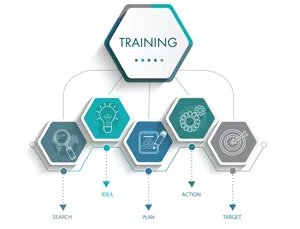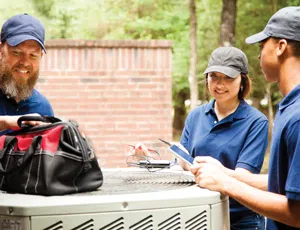Five steps to creating a long-term, strategic plan for employee education and development.
Professional development and training is part of the foundation of any employer-employee relationship. Many surveys show companies that invest in training benefit from reduced turnover, increased skill set and increased productivity.
At CroppMetcalfe, we firmly believe in developing our employees and we created the CroppMetcalfe Academy — an in-house training program as part of our long-term strategic plan.
A dynamic and often-changing initiative with multiple challenges, it’s been a rewarding experience for all involved. Here are the steps we took to create this initiative.
Step 1: Assess Your Needs
Determine the value of training.
- Why do we need training?
- What options are available outside of the organization: local vocational schools, community colleges and on-the-job training. Each has positive and negative attributes (student-teacher ratio, ability to do hands-on work in labs, expertise of the teachers, learning environment).
- How many students are involved? A one-time class for five people is different than a multi-year, apprenticeship program with multiple classes.
- Is this a short- or long-term need? How will the training align with the long-term goals of the business?
- What is the best way for students to learn? Is a classroom setting or is on-the-job training better?
- What level of training is needed? Is the need to provide entry-level training for technicians to run tune-ups? Or is the need to provide additional training for experienced technicians on specific topics (i.e. replacing a TXV)?
During a review of our business plan, we wanted to ensure a reliable pipeline of qualified, trained and educated workers. We explored alternatives and chose to develop an in-house training program.
The CroppMetcalfe Academy is a four-year apprenticeship program with a curriculum approved by Virginia. Our graduates are prepared to take the exam for their Virginia Journeyman License. We chose this program because we could control the learning environment and provide the resources to our students better than the alternatives.
Step 2: Commit the Resources, Develop the Structure
As with any new effort, you must build the structure before deciding on the finishing touches (i.e. enroll students). The structure includes many actions that were critical to ensuring success.
Hiring an instructor, developing the curriculum, setting up classrooms and labs and establishing the attendance and grading policies are all necessary steps in building a foundation.
Identify an administrator to oversee the budget and overall effort, someone who is not a teacher. By having an outside perspective, you ensure checks and balances. The administrator may be the owner, service manager or someone in human resources — but not an instructor.
All institutions have a written set of procedures stating the ground rules regarding attendance, grading procedure and standards for advancement. The expectations of students should also be clearly identified, including days/hours of classes and what constitutes an excused versus unexcused absence. A student handbook is standard, and helps ensure the training program is separate from operations.
Identifying an instructor is critical since that person will be the face of the program. His or her level of expertise and ability to teach adults is critical. That last point is important, since teaching adults is much different than teaching children. Adults learn differently and have different distractions than children.
Often, classes will be held after a long day in the field and students will be tired. The instructor will need tremendous energy, and the ability to connect and build rapport with students.
Creating an environment in which students thrive is important. If possible, set up a defined classroom with access to a projector for videos, a whiteboard or chalkboard. Setting up a lab will help with the hands-on training.
There needs to be a mix of used and new equipment in the training lab. One of the best sources of equipment is from operations. Have technicians and installers bring in used equipment to use in the training program. If you have any scratch and dent equipment that can’t be installed or returned to the supply house, consider using it in the training lab.
Developing the curriculum should be left to the Instructor, per broad guidelines from the administrator to choose carefully the number of classes per topic and mix of classroom-lab time.
Instructors must be aware of the way their students learn. Generally, the best format is to allocate time to classroom learning to explain the theory, plus some time allocated to lab work where students can observe and handle the parts, equipment or tools.
There are many videos either online or from manufacturers which can be used to supplement or reinforce the instructor-led training.
There may be specific topics for which outside vendor partners (i.e. manufacturers or manufacturer’s representatives) can share their expertise on a topic. An honest, open dialogue between the administrator and instructor will identify what topics can be delivered by the instructor and what topics are best taught by someone outside of the organization. Using outside providers also covers planned absences of the Instructor.
The CroppMetcalfe Academy has two full-time, plus several part-time instructors and several spaces for hands-on labs, both inside and outside our facility. All students have online access to training materials and videos, plus the ability to view classes online if they missed or need a refresher on a topic.
All of our instructors have taken a class on teaching adults. Teaching requires a unique skill set and we invested in our teachers to give them the tools to succeed. All of our teachers held management positions previously, but the student-teacher relationship is much different than that of an employee-supervisor.
Step 3: Go for Launch!
The first session with students is a gratifying, yet anxious time. Instructors learn how to connect with their students in a wide range of options to deliver their instructions: instructor-led discussions, classroom training, webinars, e-learning, lab assignments, etc. Students must balance their “day job” with being a student and committing to their studies and assignments.
It’s important to give feedback plus periodic check-ins with the students. This could range from quizzes to lab assignments and allows the instructor to gauge the retention of the material as well as provide insight into teaching future topics.
The first session also identifies any gaps in preparation or needs of the lab or classroom setup. This would not necessarily indicate a failure. It’s an opportunity to improve the program. Do you need more equipment for labs? Do you need different slides or videos for any specific topic?
During the first session, you may want to pivot away from some elements of the course curriculum since your company has a unique way of doing a common task, or a process not widely used by other companies. In these situations, you’ll want to document these special items so students have reference documents.
A good practice is report cards. At the conclusion of every semester or class, instructors should distribute report cards showing grades and hours attended. This provides a sense of closure, but also reinforces to everyone that this effort is to be taken seriously.
Each company can determine the requirements to advance to the next class or level of training. Setting a standard is important and there should be zero variances due to “good behavior.”
No amount of preparation is enough. It seemed every week during the first year of CroppMetcalfe Academy, we were scrambling for lab materials (copper for a brazing class, refrigerant scales, etc.), that wasn’t considered initially. So plan, plan, plan!
Step 4: Review & Feedback
Just as the students deserve a report card, the training program should also be reviewed after every school year is completed. This is another benefit of having an administrator different than the instructor.
The administrator must solicit and collect feedback on everything involved in the program (i.e. instructors, classroom and lab setting, assignments, and tests). It’s the administrator’s fiduciary duty to provide the best training program to the students.
Part of the feedback should come from the managers/supervisors of the students. Is their skill set improving? Are they using the lessons from school on a daily basis? What are the gaps that need to be addressed?
After every school year, the CroppMetcalfe Academy sends a survey to every student which asks about the program. This feedback is reviewed to improve future sessions. As with any survey, it’s important to not take anything personally, but rather view it as a way to improve the process.
The administrator has a long-term perspective on the program so he/she should review its effectiveness. The feedback from our students made each subsequent semester better. We added more labs and hands-on projects as a direct result of the feedback during our first year.
Step 5: Just Do It
Setting up an in-house training program is the right thing to do. It’s a commitment to the company’s future, and a sign to your employees about your commitment to them.
It’s also a sign to the local labor market that your company makes professional development a priority.
The CroppMetcalfe Academy has been a great way to develop our HVACR and plumbing technicians’ skill set, reinforce the concept of continuous learning and grow technicians with no background to licensed journeymen.





